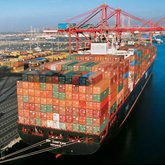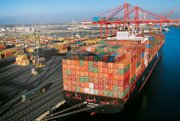East Coast Ports Behind on Accommodating Bigger Ships
The arrival of the largest cargo-container ship to ever sail to the United States was much ballyhooed by Southern California’s Port of Long Beach, which received the MSC Fabiola at its docks on March 16.
The gargantuan vessel, owned by Geneva-based Mediterranean Shipping Co., is capable of carrying up to 12,500 20-foot containers, making it one of the largest cargo-container ships in the world and an example of the ships of the future. It dwarfs the typical cargo ship that hauls around 8,000 containers on the trans-Pacific route between Asia and the West Coast.
When the Panama Canal expansion project is completed in 2014, the waterway will be able to handle vessels the size of the MSC Fabiola. Currently, ships carrying no more than 4,800 containers can pass through the locks.
The MSC Fabiola’s arrival was a floating advertisement for the Port of Long Beach, which, like its neighbor port, the Port of Los Angeles, can accommodate the bigger ships, which need 50-foot channels and waterways to dock.
But the two ports are worried that the post-Panamax ships, such as the MSC Fabiola, will skip California and instead use the Panama Canal to sail directly from Asia to the East Coast on an all-water route to deliver merchandise to the heaviest-populated areas of the United States. Currently, cargo containers unloaded on the West Coast are shipped to the Midwest and the East by trucks or rail.
But will the East Coast ports be ready?
At the Port of New York and New Jersey, the largest port on the East Coast, all its channels will be deepened in time for the expanded Panama Canal. Yet there is one very tall hurdle: the Bayonne Bridge, which connects Staten Island, N.Y., to New Jersey.
Completed in 1931, the bridge has an air draft of only 151 feet, which is fine for a ship carrying 8,000 containers but not high enough for the mega ships.
With the majority of the port’s cargo-container terminals to the west of the Bayonne Bridge, bigger cargo vessels can’t clear the bridge to reach the terminals from the Atlantic. Port officials have set out to alter the steel expanse with a project that won’t be completed until 2016. “We have a fix in place,” said Richard Larrabee, director of port commerce at the Port of New York and New Jersey, who spoke at the recent Trans-Pacific Maritime conference in Long Beach, Calif. “We will raise the road bed by 2016 to 215 feet.”
The $1 billion project is complicated. Two lanes of the four-lane roadway will be closed to raise one side of the thoroughfare. After that portion is completed and reopened, the other two lanes will be closed and raised.
Modernization projects are also going slowly at the second-largest port on the East Coast, the Port of Savannah in Georgia. Port officials there are undertaking a project to deepen 32 miles of the Savannah River, which connects the Atlantic Ocean to the Port of Savannah, by six feet, making it 48 feet deep. Because the river is under federal jurisdiction, the port has been wading through years of government bureaucracy. “Reconnaissance started on this project in 1996,” said a frustrated Curtis Foltz, executive director of the Georgia Ports Authority. “It was authorized by Congress in 1999, and the study has just been completed. We have spent 12 years and $40 million studying the need to deepen this river.”
He said the Savannah River project won’t be completed until the end of 2016, missing the deadline to accept the mega ships passing through the Panama Canal. That timeline might be delayed by lawsuits filed by environmental groups.
However, the Port of Savannah has the ability to receive vessels carrying as many as 9,200 20-foot cargo containers, Foltz said.
In neighboring South Carolina, Port of Charleston officials are playing catch-up with Georgia. The U.S. Army Corps of Engineers recently authorized a project to deepen the port’s harbor from 45 feet to 50 feet, said Jim Newsome, president and chief executive of the South Carolina Ports Authority. The project hasn’t started yet, but Newsome wants to be ready by 2014 because nearly half the cargo-container ships plying the trade routes will be transporting between 5,000 to 18,000 containers per ship. “There are too many large ships not to deploy them on long routes [from Asia through the Panama Canal to the East Coast].”
The Port of Miami was planning to start its dredging project this summer, but that has been put on hold while the port answers legal challenges made by various environmental groups that want to protect Biscayne Bay and the local bird population.
Only two East Coast ports have gotten their docks into ship-shape form to handle the mega-ship onslaught. The Port of Virginia and the Port of Baltimore have successfully dredged their channels to 50 feet and are ready for business.
The smaller Port of Baltimore has a 50-foot channel and a 50-foot container berth.
The Port of Virginia includes four marine terminals in Hampton Roads. Hampton Roads now has a 50-foot-deep channel and authorization to deepen it to 55 feet.
“We are the biggest, deepest, newest and the best,” boasted Jerry Bridges, executive director of the Virginia Port Authority, who was at the same maritime conference as the other port directors. “We are determined to set ourselves apart.”
Meanwhile, the Port of Los Angeles is able to accept mega ships at its outer piers. And a project to deepen the main channel to 53 feet is expected to be completed by the end of this year.























